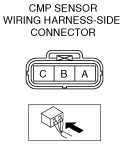 |
am6zzw00004020
CAMSHAFT POSITION (CMP) SENSOR INSPECTION [MZR-CD 2.2]
id0140f2801400
Visual Inspection
1. Verify that the CMP sensor and the pulsar are free of any metallic shavings or particles.
Air Gap Inspection
1. Verify that the CMP sensor is securely installed.
2. Using a thickness gauge, measure the air gap between the plate projections at the back of crankshaft pulley and the CMP sensor.
Voltage inspection
1. Idle the engine.
2. Measure the output voltage using a oscilloscope.
am6zzw00004020
|
CMP sensor voltage
|
Terminal |
Voltage (V) |
Condition |
|---|---|---|
|
A
|
4.0 or more
|
High output
|
|
1.0 or less
|
Low output
|
|
|
B
|
0
|
Under any condition
|
|
C
|
5
|
Under any condition
|